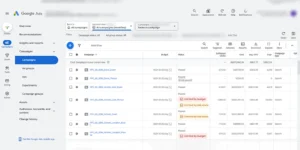Introduction
Automated bidding strategies, like Google’s Smart Bidding, have revolutionized the digital advertising landscape, allowing advertisers to optimize their bids in real time based on various signals and data points. This case study explores how a mid-sized e-commerce company successfully leveraged Smart Bidding to enhance its advertising performance and drive significant business growth.
The Company: E-Shopify
E-Shopify, a mid-sized e-commerce business specializing in fashion accessories, faced challenges in maximizing the efficiency of its Google Ads campaigns. With a diverse product range and a competitive market, E-Shopify aimed to improve its return on ad spend (ROAS) and increase its overall conversion rates without drastically increasing its advertising budget.
The Challenge
Before implementing Smart Bidding, E-Shopify relied on manual bidding strategies. This approach was time-consuming and often led to suboptimal performance due to the inability to react swiftly to market changes and user behavior patterns. The primary challenges included:
- Inefficient Bid Management: Manual adjustments must be made more timely to capitalize on peak user engagement periods.
- Low ROAS: Difficulty in balancing spend and returns across various campaigns.
- Inconsistent Conversions: Fluctuating conversion rates due to the need for real-time bid optimization.
The Solution: Implementing Smart Bidding
E-Shopify decided to implement Google’s Smart Bidding strategies, which use machine learning to optimize bids for each auction, helping to achieve specific goals such as maximizing conversions or hitting a target ROAS. The strategy used included:
- Target ROAS: To ensure that ad spend was aligned with revenue goals.
- Maximize Conversions: To increase the number of purchases made through the ads.
- Enhanced CPC (Cost-Per-Click): To automatically adjust manual bids to maximize conversions.
Implementation Steps
- Data Collection and Setup:
- Ensured conversion tracking was correctly set up to provide accurate data for Smart Bidding algorithms.
- Gathered historical performance data to allow the machine learning model to make informed decisions.
- Campaign Segmentation:
- Segmented campaigns based on product categories to tailor bidding strategies to specific product lines.
- Created separate campaigns for high-margin and low-margin products, applying different target ROAS values.
- Smart Bidding Activation:
- Enabled Smart Bidding across selected campaigns, starting with a pilot phase to monitor initial performance.
- Gradually rolled out Smart Bidding to all campaigns after successful pilot results.
- Continuous Monitoring and Optimization:
- Regularly monitored campaign performance using Google Ads reports and analytics tools.
- Adjusted target ROAS and other bidding parameters based on performance data and changing business goals.
Results
The implementation of Smart Bidding strategies yielded impressive results for E-Shopify:
- Increased ROAS: The overall ROAS improved by 35%, enabling better profitability for advertising spend.
- Higher Conversion Rates: The conversions increased by 28%, directly impacting sales and revenue growth.
- Time Efficiency: The marketing team saved significant time previously spent on manual bid adjustments, allowing them to focus on strategic initiatives.
- Optimized Ad Spend: The automated bidding ensured the budget was allocated more efficiently, reducing wastage and improving cost-effectiveness.
Key Learnings and Best Practices
- Data Quality: Accurate and comprehensive conversion tracking is critical for Smart Bidding success. E-Shopify ensured that their tracking was precise and reflected true user behavior.
- Pilot Phases: Starting with a pilot phase allowed E-Shopify to gauge the effectiveness of Smart Bidding and make necessary adjustments before a full-scale rollout.
- Regular Monitoring: Continuous monitoring and adjustments helped fine-tune the campaigns and maintain optimal performance.
- Segmentation: Segmenting campaigns by product categories and margin levels enabled more targeted and effective bidding strategies.
Conclusion
The case study of E-Shopify demonstrates the transformative potential of Smart Bidding for digital advertisers. By leveraging Google’s automated bidding strategies, E-Shopify improved its ROAS and conversion rates and streamlined its ad management processes. Smart Bidding allowed the company to make data-driven decisions in real-time, optimizing their ad spend and achieving sustainable business growth. For other advertisers looking to enhance their Google Ads performance, Smart Bidding offers a powerful solution that can adapt to dynamic market conditions and deliver significant results.





